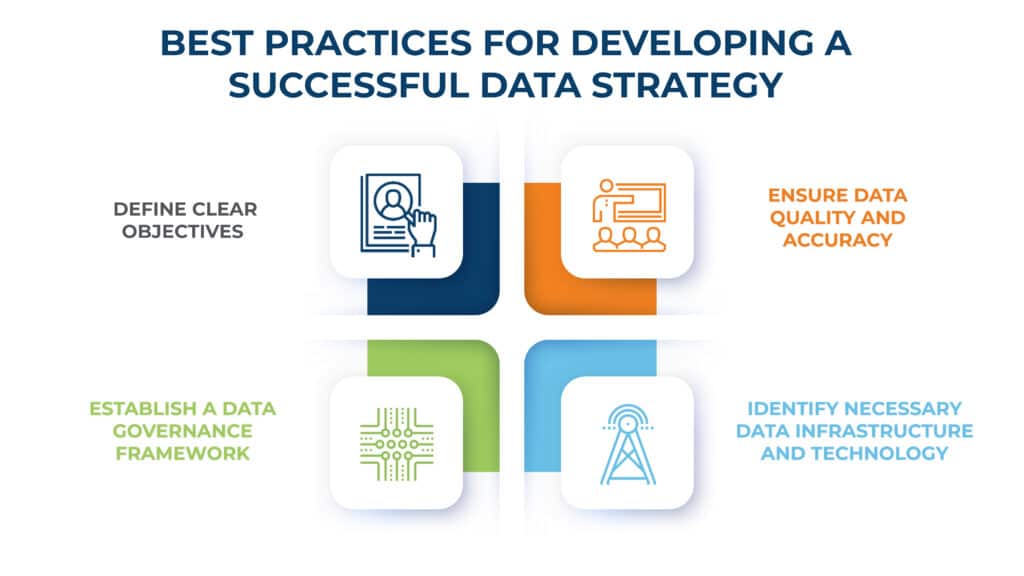Developing a Data Strategy: Best Practices for Data Management and Analytics Success
Understand the best practices for data management strategies and analytics that will help your organization achieve success.
The emergence of generative AI is proving just how quickly technology can evolve. With each new tool or advancement, our collective technological landscape takes an exponential leap forward. How might this impact how companies develop an effective data strategy?
The acceleration of technology is fueled by data. Without data, things like ChatGPT wouldn’t exist. Data is a powerful business tool that’s becoming more available as technology advances. Businesses are increasingly relying on data to make smart business decisions that lead to successful outcomes. Those who aren’t leveraging data will most surely be left behind.
“Everyone is generating data, but the winners are leveraging it.” – Jonathan McNutt, Data Engineer at Velosio
Leveraging data is key to moving a business forward. Businesses that use data insights can more easily pivot with changing market conditions and adapt to new technologies. Businesses armed with the power of data are the ones gaining a serious competitive edge. They’re also the ones following a data strategy.
A comprehensive data strategy gives you clarity and empowers you to make smart, informed decisions about the future of your business. Leveraging your data strategically can result in cost savings, better hiring, improved agility, and even help safeguard business continuity.
In this article, we’ll dive deep into the importance of developing a comprehensive data strategy to drive success in your business. You’ll learn the key factors that your business should consider when developing a data strategy, and some of the most common mistakes businesses make surrounding data.
 A data strategy defines how a business will use data to achieve its business goals. Think of a data strategy as a roadmap for your data management and analytics initiatives about your business objectives.
A data strategy defines how a business will use data to achieve its business goals. Think of a data strategy as a roadmap for your data management and analytics initiatives about your business objectives.
A comprehensive data strategy considers your entire business ecosystem from the actual technology you use to the people who use it. Data strategies can help you make one-off technical decisions, but they can also help inform the timing of upgrades and who to hire to support future growth.
As technology rapidly advances, businesses should pay close attention to not only how data is currently collected and used, but also how data might be used in the future as data collection methods evolve.
We’re already seeing some of the early benefits of generative AI technology on business efficiencies. But as the promise of AI continues to play out, it’s important to remember that the opportunities and risks associated with technology all stem from data.
In this new digital age, business continuity depends on successful data management. Businesses that avoid data breaches and use data in innovative ways will experience intangible benefits, such as increased credibility, trust, and brand loyalty. Businesses that can pivot and remain agile in the face of technology disruptions will outlast those that haven’t prioritized their data.
When asked the best time to develop a data strategy, Jonathan McNutt, a Data Engineer at Velosio, says, “The right time is yesterday. If not yesterday, today.” Because most business goals hinge on the use of data, developing a data strategy now will only help your business succeed in the future.

As cyber threats and the future of AI loom on the horizon, more businesses are beginning to see the benefits of leveraging data in their organizations. Despite this renewed focus on data, data management continues to be a blind spot for many organizations. Businesses are often challenged to leverage data successfully due to the effects of poor internal communication, office politics, or uninformed leadership.
McNutt emphasizes that developing a data strategy is a collaborative effort. While an IT department might lead a data strategy initiative, it’s ultimately driven by the overarching goals and objectives of the business. However, if leadership does not understand the potential benefits of technology on the business, developing a data strategy will prove to be quite challenging.
Here are some of the most common mistakes businesses make when developing a data strategy:
Developing a data strategy requires a thorough understanding of an organization’s business goals, data needs, and capabilities. Read on to learn how to develop a data strategy that drives business success.

The first step in developing a successful data strategy is to define clear objectives for your strategy. Aligning these objectives with your overall business goals is key to developing – and executing – a successful data strategy.
Start by identifying the key constraints and drivers within your business. Take into account your budget and the skills and experiences of your existing staff. This can help determine what aspects of your data strategy are achievable for your organization.
For example, to achieve certain outcomes as outlined in your data strategy, you may need to pay for more premium services or hire someone skilled in a particular coding language. Mapping the objectives in your data strategy to your budget is key.
Your data strategy objectives should also be measurable. Defining the metrics or KPIs you’ll use to measure progress ensures your data strategy stays aligned with your business goals. Consider running drills to make sure your goals are actually achievable.
Ensuring your data is accurate and of high quality is critical to executing a successful data strategy. It’s important to consider factors such as accuracy, completeness, consistency, and relevance when determining the quality of your data.
Your data strategy can also address how to improve data quality. Including this in your strategy can help with consistency and accountability across your organization. Establishing strong data governance policies, selecting the right tools and technologies, and encouraging a data-driven culture can also help to improve data quality.
Understanding and using data correctly is an important factor in ensuring you’re working with high-quality data. The objectives defined in the data strategy should guide your organization on the proper use of data, which will help ensure your data is accurate and usable.
Establishing a data governance framework is one of the biggest drivers in developing a successful data strategy. Data governance frameworks are the policies, procedures, and standards you set for managing data across your organization.
A solid framework builds controls to ensure data integrity, consistency, and security. To establish a data governance framework, start by identifying who will be responsible for implementing and maintaining any new or existing technology.
Having the right people on your team is key to remaining flexible in a quickly changing landscape. What’s also important is hiring people with diverse perspectives and skills. This is especially important with the rise of generative AI models.
As McNutt points out, there’s no end to the possibilities with generative AI technology. Depending on someone’s background and perspective, they’ll use the same AI model in ways you won’t think of. Having diverse perspectives on your team can be a smart strategy to drive innovation and ensure adaptability.
Building a data-driven culture is ultimately what it takes to develop and implement a successful data strategy. Offering incentives and making sure motivations align with data strategy objectives ensures the strategy will come alive.
While people and culture are the ultimate drivers of a successful data strategy, effective data management is made possible by using the right tools and technologies. The tools and technologies you choose should not only support your defined data strategy objectives but also your entire business ecosystem.
An effective data strategy considers a business’ technical debt, or the outdated servers, systems, and technology that will become a risk in the future. The strategy should outline exactly how the business will incrementally update systems, taking into account budget projections and the future financial growth of the business.
As you consider developing a data strategy for your business in an environment that’s changing rapidly, it’s important to keep one eye on the horizon while the other stays fixed on running your business to the best of your ability.
McNutt recommends that businesses “fail fast” and position to adapt to the changing landscape quickly. A strong data strategy should enable you to pivot on a dime and help you achieve success now and in the future.
If you’re interested in finding success with a data strategy, our team at Velosio is here to help guide you.